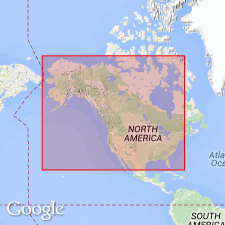
- Usage in publication:
-
- Ocala limestone*
- Modifications:
-
- Original reference
- Dominant lithology:
-
- Limestone
- AAPG geologic province:
-
- Florida platform
- South Georgia sedimentary province
Summary:
Pg. 103, 157, 331 [credited to Dall]. Ocala limestone. Yellowish friable rock containing many Foraminifera, conspicuous among which are two species of NUMMULITES (N.WILLCOXII and N. FLORIDANA Hp.), which appears in central Florida directly and conformably to overlie ORBITOIDES limestone (Vicksburg). It is best displayed at Ocala, Florida, where it forms the country rock and has been quarried to a depth of 20 feet without coming to bottom of the beds. [Other places where it is exposed are mentioned.] Assigned to "Eocene or 'Oligocene'."
[GNC remark (ca. 1926, US geologic names lexicon, USGS Bull. 896, p. 1527): Later studies by C.W. Cooke (see Alabama Geol. Survey Spec. Rpt., no. 14, 1926) have proved this limestone to be of Jackson (late Eocene) age and to underlie Vicksburg group of limestones.]
Source: US geologic names lexicon (USGS Bull. 896, p. 1526-1527).
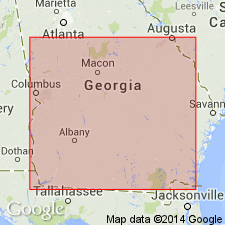
- Usage in publication:
-
- Ocala limestone
- Modifications:
-
- Revised
- AAPG geologic province:
-
- South Georgia sedimentary province
Summary:
Pg. 51-56. Ocala limestone. Includes Tivola tongue. [Age is late Eocene (Jackson).]
Source: US geologic names lexicon (USGS Bull. 1200, p. 2795-2796).
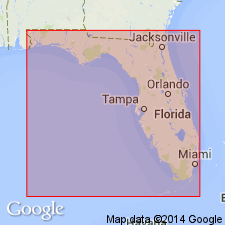
- Usage in publication:
-
- Ocala limestone
- Modifications:
-
- Revised
- AAPG geologic province:
-
- Florida platform
- South Georgia sedimentary province
Summary:
As now understood Ocala limestone comprises all rock of Eocene age exposed in Florida. This includes "Orbitoidal," Nummulitic," and "Millolitic" limestones of Dall as well as "Peninsular" limestone as interpreted by Matson. The Ocala limestone is of Jackson (late Eocene) age.
Source: US geologic names lexicon (USGS Bull. 896, p. 1526-1527).
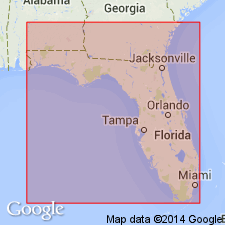
- Usage in publication:
-
- Ocala limestone
- Modifications:
-
- Biostratigraphic dating
- AAPG geologic province:
-
- Florida platform
- South Georgia sedimentary province
Summary:
Pg. 1683-1686. Ocala limestone of Jackson group. Two-fold faunal division recognized. Upper member is typical Ocala seen at outcrop on Ocala uplift. Lower member, not known on outorop, is light cream-colored limestone, commonly harder than upper member, generally highly calcitic and ordinarily composed of molds of small miliolids. Overlies Avon Park limestone (new). Age is late Eocene.
Source: US geologic names lexicon (USGS Bull. 1200, p. 2795-2796).
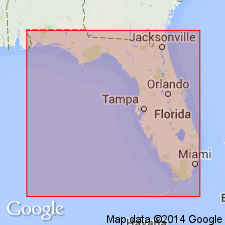
- Usage in publication:
-
- Ocala limestone
- Modifications:
-
- Areal extent
- AAPG geologic province:
-
- Florida platform
- South Georgia sedimentary province
Cooke, C.W., 1945, Geology of Florida: Florida Geological Survey Bulletin, no. 29, 339 p.
Summary:
Pg. 56. Ocala limestone. Ocala transgresses beveled surface of Avon Park, Tallahassee, and Lake City limestones. Top of Ocala was land surface before younger marine deposits were laid down. Ocala is overlain by Marianna limestone, Byram limestone, and Suwannee limestone, or Hawthorn formation. [Age is late Eocene.]
Source: US geologic names lexicon (USGS Bull. 1200, p. 2795).
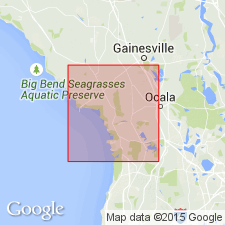
- Usage in publication:
-
- Ocala limestone
- Modifications:
-
- Revised
- AAPG geologic province:
-
- Florida platform
Summary:
Pg. 156-171. Ocala limestone. Restricted by separation of thickness of about 80 feet from base, which is Moodys Branch formation. Underlies Suwannee limestone. As restricted in this report, includes marine limestone of peninsular Florida of upper Jackson age that contains high percentage of specimens of larger foraminifers, LEPIDOCYCLINA, HETEROSTEGINA, and various camerinids, as developed in Polk and adjacent counties in well penetrations. Base of this interval is exposed at type locality where formation is massive coquina. Thickest exposure is at Crystal River Rock Company quarry in SW/4 T. 19 S., R. 18 E., Citrus County, where minimum of 107.9 feet of unit is exposed. [Age is late Eocene.]
Source: US geologic names lexicon (USGS Bull. 1200, p. 2795-2796).
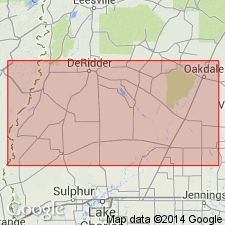
- Usage in publication:
-
- Ocala group
- Ocala limestone
- Modifications:
-
- Areal extent
- AAPG geologic province:
-
- Gulf Coast basin
Summary:
Pl. 13. Ocala group used on diagram to include Moodys Branch and Ocala (restricted) of Vernon. [Age is late Eocene.]
Source: US geologic names lexicon (USGS Bull. 1200, p. 2795-2796).
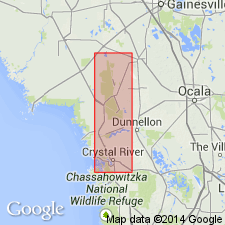
- Usage in publication:
-
- Ocala group
- Modifications:
-
- Revised
- AAPG geologic province:
-
- Florida platform
Summary:
Pg. 130. Ocala group. Rank raised to group. Includes all calcareous sediments of Jackson stage in Florida. Comprises (ascending) Inglis, Williston, and Crystal River (new) formations. [Age is late Eocene.]
Source: US geologic names lexicon (USGS Bull. 1200, p. 2795-2796).
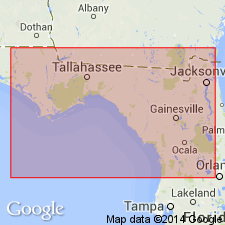
- Usage in publication:
-
- Ocala group
- Modifications:
-
- Principal reference
- Biostratigraphic dating
- AAPG geologic province:
-
- Florida platform
- South Georgia sedimentary province
Summary:
Ocala group. Comprises (ascending) Inglis, Williston, and Crystal River formations. Because "Ocala limestone" at type locality has been quarried and type section destroyed and exposures in vicinity of Ocala represent only about 40 feet of sediments (basal section in most pits belongs to Williston member) cotype locality is herein designated. Thickness about 70 feet at cotype locality. Fossils. Foraminifera described. Faunizones listed. [Age is late Eocene.]
Source: US geologic names lexicon (USGS Bull. 1200, p. 2795-2796).
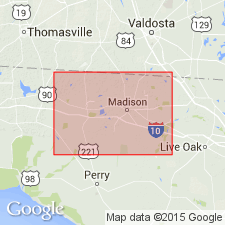
- Usage in publication:
-
- Ocala Group
- Modifications:
-
- Areal extent
- AAPG geologic province:
-
- Florida platform
Summary:
Ocala Group is not differentiated in this report because of limited outcrops and subsurface data. Unit is the oldest exposed in Madison Co. Outcrops occur in extreme southeastern part of county along the Suwannee River. Unit is generally a pale orange to white, poorly to moderately indurated, moderately to highly porous, micro-fossiliferous, partially dolomitized, partially recrystallized limestone, but several cores are composed primarily of dolomite. The Foraminifera LEPIDOCYCLINA is common to abundant and distinguishes this unit from the younger Suwannee Limestone. Thickness range is estimated at 80 to 210 ft. The Ocala unconformably overlies the middle Eocene Avon Park Formation and unconformably underlies the Oligocene Suwannee Limestone. Age is late Eocene.
Source: GNU records (USGS DDS-6; Reston GNULEX).
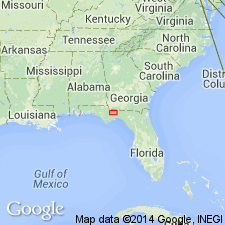
- Usage in publication:
-
- Ocala Group
- Modifications:
-
- Areal extent
- AAPG geologic province:
-
- Florida platform
Summary:
Nomenclature proposed by Puri (1957) is generally used today by the Florida Geological Survey. The Ocala Group is composed of the (ascending) Inglis, Williston, and Crystal River Formations. It is known from well data to underlie most of FL. In report area, unit is cream colored, highly fossiliferous, crystalline limestone containing abundant benthonic Foraminifera and bryozoans. Contains various amounts of quartz sand, dolomite, and clay. Crystal River Formation may compose approximately the upper two-thirds of the Ocala Group in Gadsden Co. (Puri and Vernon, 1964), though the Ocala Group was mapped as undifferentiated in Jackson Co. by Schmidt and Coe (1978). Formational picks were not made in any of the wells is this study as the unit is massive, frequently recrystallized, and lacks definitive index fossils.
Source: GNU records (USGS DDS-6; Reston GNULEX).
- Usage in publication:
-
- Ocala Limestone
- Modifications:
-
- Revised
- AAPG geologic province:
-
- Florida platform
- South Georgia sedimentary province
Scott, T.M., 1991, A geological overview of Florida: Florida Geological Survey Special Publication, no. 32, p. 5-14.
Summary:
Pg. 6-7, 20 (fig. 4). Ocala Limestone. Divided into: (1) upper part, variably muddy (carbonate), granular limestone (packstone to wackestone with limited grainstone), often very soft and friable with large foraminifera, commonly contains chert; and (2) lower part, where present is a more granular limestone (grainstone to packstone) and is dolomitized in some places. In Florida Panhandle, underlies Bucatunna Clay Member of Byram Formation and unconformably overlies Claiborne Group sediments, elsewhere underlies Suwannee Limestone and overlies Avon Park Formation. Age is late Eocene.
[Ocala Group of Puri (1953) reduced to formation rank and its Crystal River, Inglis, and Williston formations are abandoned.]
Source: Publication.

- Usage in publication:
-
- Ocala Limestone
- Ocala Group
- Modifications:
-
- Overview
- AAPG geologic province:
-
- Florida platform
Summary:
Because Puri's (1957) subdivisions of the Ocala are essentially biostratigraphic, the Florida Geological Survey has officially adopted the original lithostratigraphic term Ocala Limestone as stated in Scott and others (1991: FL Geol. Survey Special Pub. 32). Upper and lower subdivisions of the Ocala can generally be recognized lithologically. Use of Ocala Group in GA with its Ocmulgee Formation and Tivola Limestone is advisable. Age is middle to late Eocene.
Source: GNU records (USGS DDS-6; Reston GNULEX).
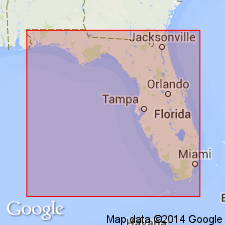
- Usage in publication:
-
- Ocala Limestone
- Modifications:
-
- Areal extent
- AAPG geologic province:
-
- Florida platform
Summary:
The Ocala outcrops in the northern FL peninsula, is missing only locally in the central peninsula, and is absent in the southeastern portion of the peninsula. Subdivisions of the Ocala have been abandoned by the Florida Geological Survey as they are not identifiable in the subsurface and the basal dolomite facies where present has been assigned to the underlying Avon Park Formation by the Survey. The Ocala as it is now defined is almost entirely a limestone unit. Typically it is a cream-colored coquina of foraminifers and skeletal debris in the upper part, and a cream chalky micrite in the lower section. In the southwestern peninsula, where diagnostic fossils are absent, it is difficult to separate from the overlying Suwannee. It is difficult to separate from the underlying Avon Park where that unit is also a micrite. Author suggests that contrary to popular belief, no major unconformities from tectonic activity exist in south FL and the boundaries between the Ocala and the under- and overlying units are simple facies changes. In southeastern FL, the Avon Park lithology merges directly into the overlying Suwannee.
Source: GNU records (USGS DDS-6; Reston GNULEX).
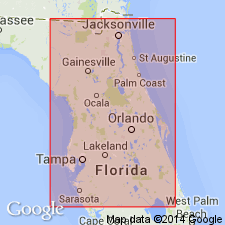
- Usage in publication:
-
- Ocala Limestone*
- Modifications:
-
- Age modified
- Geochronologic dating
- Biostratigraphic dating
- AAPG geologic province:
-
- Florida platform
Summary:
Historically, contact between Ocala Limestone and Suwannee Limestone represented Eocene-Oligocene boundary in peninsular FL. This study indicates little if any time is missing at boundary of the two units. Sr age estimates place upper part of Ocala in late Eocene and earliest Oligocene at four localities from northern and eastern portions of peninsula. Possible early Oligocene mollusk found in Ocala on east coast. Gradual change in TURRITELLA mollusk lineage can be seen across Eocene-Oligocene transition, implying little if any time missing.
Source: GNU records (USGS DDS-6; Reston GNULEX).
For more information, please contact Nancy Stamm, Geologic Names Committee Secretary.
Asterisk (*) indicates published by U.S. Geological Survey authors.
"No current usage" (†) implies that a name has been abandoned or has fallen into disuse. Former usage and, if known, replacement name given in parentheses ( ).
Slash (/) indicates name conflicts with nomenclatural guidelines (CSN, 1933; ACSN, 1961, 1970; NACSN, 1983, 2005, 2021). May be explained within brackets ([ ]).

